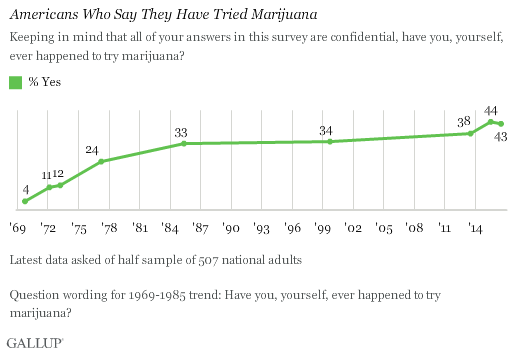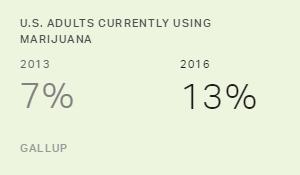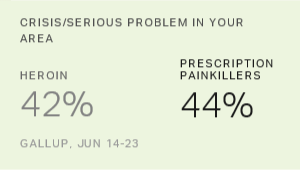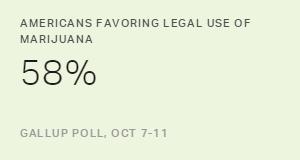Story Highlights
- 13% report being current marijuana users, up from 7% in 2013
- 43% of U.S. adults say they have tried it
- Use and experimentation differ by religiosity, age
WASHINGTON, D.C. -- Thirteen percent of U.S. adults tell Gallup they currently smoke marijuana, nearly double the percentage who reported smoking marijuana only three years ago.
| Yes, do | No, do not | ||||||||||||||||||||||||||||||||||||||||||||||||||||||||||||||||||||||||||||||||||||||||||||||||||
|---|---|---|---|---|---|---|---|---|---|---|---|---|---|---|---|---|---|---|---|---|---|---|---|---|---|---|---|---|---|---|---|---|---|---|---|---|---|---|---|---|---|---|---|---|---|---|---|---|---|---|---|---|---|---|---|---|---|---|---|---|---|---|---|---|---|---|---|---|---|---|---|---|---|---|---|---|---|---|---|---|---|---|---|---|---|---|---|---|---|---|---|---|---|---|---|---|---|---|---|
| % | % | ||||||||||||||||||||||||||||||||||||||||||||||||||||||||||||||||||||||||||||||||||||||||||||||||||
| July 13-17, 2016^ | 13 | 87 | |||||||||||||||||||||||||||||||||||||||||||||||||||||||||||||||||||||||||||||||||||||||||||||||||
| July 8-12, 2015^ | 11 | 88 | |||||||||||||||||||||||||||||||||||||||||||||||||||||||||||||||||||||||||||||||||||||||||||||||||
| July 10-14, 2013^ | 7 | 93 | |||||||||||||||||||||||||||||||||||||||||||||||||||||||||||||||||||||||||||||||||||||||||||||||||
| ^ Based on a half sample | |||||||||||||||||||||||||||||||||||||||||||||||||||||||||||||||||||||||||||||||||||||||||||||||||||
| Gallup | |||||||||||||||||||||||||||||||||||||||||||||||||||||||||||||||||||||||||||||||||||||||||||||||||||
Although use of the drug is still prohibited by federal law, the number of states that have legalized recreational marijuana use has grown from two in 2013, Colorado and Washington, to four today -- with the addition of Alaska and Oregon -- plus the District of Columbia. Five states will vote on whether to legalize marijuana this November.
Half of U.S. states (including the four above) have some variation of a medicinal marijuana law on the books, and four more will be voting this fall on whether to legalize marijuana for medicinal use. Both major-party presidential candidates, Hillary Clinton and Donald Trump, have voiced support for medicinal marijuana but say they defer to the states in terms of policymaking on both recreational and medicinal marijuana use.
States' willingness to legalize marijuana could be a reason for the uptick in the percentage of Americans who say they smoke marijuana, regardless of whether it is legal in their particular state. Gallup finds residents in the West -- home of all four states that have legalized recreational marijuana use -- are significantly more likely to say they smoke marijuana than those in other parts of the country.
Gallup has found that majorities of Americans have supported legalizing marijuana since 2013.
More Than Four in 10 Say They Have Tried Marijuana
More broadly, 43% of Americans say they have ever tried marijuana, similar to the 44% recorded last year and up slightly from 38% in 2013. The percentage of Americans who say they have tried the drug has slowly increased from 4% in 1969.

Between 1969 and 1977, young adults were the group most likely to experiment with marijuana. But as those adults have aged and successive generations have joined their ranks, the overall percentage having ever tried it has sharply increased.
The latest data come from Gallup's July 13-17 Consumption Habits poll.
Age and Religiosity Key Predictors of Current Marijuana Use
To compare marijuana use among various subgroups, Gallup aggregated data from 2013, 2015 and 2016.
The results show that age and religiosity are key determinants of marijuana use. Almost one in five adults (19%) under the age of 30 report currently using it -- at least double the rate seen among each older age group. Only 2% of weekly churchgoers and 7% of less frequent attenders say they use marijuana, but this rises to 14% of those who seldom or never attend a religious service.
The pattern by age in ever having used marijuana does not show the same skew toward the young; instead, it peaks among the middle-aged. About half of adults between the ages of 30 and 49 (50%) and between 50 and 64 (48%) report having tried it. Despite being less likely to currently smoke marijuana, these older Americans could be more likely than their younger peers to report having tried it because they've had more years to do so. But this difference in their rates of experimentation could also reflect generational cultures and attitudes toward marijuana that have shifted over time.
| Smoke marijuana | Have tried marijuana | ||||||||||||||||||||||||||||||||||||||||||||||||||||||||||||||||||||||||||||||||||||||||||||||||||
|---|---|---|---|---|---|---|---|---|---|---|---|---|---|---|---|---|---|---|---|---|---|---|---|---|---|---|---|---|---|---|---|---|---|---|---|---|---|---|---|---|---|---|---|---|---|---|---|---|---|---|---|---|---|---|---|---|---|---|---|---|---|---|---|---|---|---|---|---|---|---|---|---|---|---|---|---|---|---|---|---|---|---|---|---|---|---|---|---|---|---|---|---|---|---|---|---|---|---|---|
| % Yes | % Yes | ||||||||||||||||||||||||||||||||||||||||||||||||||||||||||||||||||||||||||||||||||||||||||||||||||
| Men | 12 | 48 | |||||||||||||||||||||||||||||||||||||||||||||||||||||||||||||||||||||||||||||||||||||||||||||||||
| Women | 7 | 34 | |||||||||||||||||||||||||||||||||||||||||||||||||||||||||||||||||||||||||||||||||||||||||||||||||
| 18 to 29 years old | 19 | 38 | |||||||||||||||||||||||||||||||||||||||||||||||||||||||||||||||||||||||||||||||||||||||||||||||||
| 30 to 49 years old | 9 | 50 | |||||||||||||||||||||||||||||||||||||||||||||||||||||||||||||||||||||||||||||||||||||||||||||||||
| 50 to 64 years old | 7 | 48 | |||||||||||||||||||||||||||||||||||||||||||||||||||||||||||||||||||||||||||||||||||||||||||||||||
| 65+ years old | 3 | 21 | |||||||||||||||||||||||||||||||||||||||||||||||||||||||||||||||||||||||||||||||||||||||||||||||||
| Annual income less than $30,000 | 14 | 41 | |||||||||||||||||||||||||||||||||||||||||||||||||||||||||||||||||||||||||||||||||||||||||||||||||
| Annual income $30,000 to <$75,000 | 9 | 41 | |||||||||||||||||||||||||||||||||||||||||||||||||||||||||||||||||||||||||||||||||||||||||||||||||
| Annual income $75,000+ | 9 | 43 | |||||||||||||||||||||||||||||||||||||||||||||||||||||||||||||||||||||||||||||||||||||||||||||||||
| High school education or less | 9 | 40 | |||||||||||||||||||||||||||||||||||||||||||||||||||||||||||||||||||||||||||||||||||||||||||||||||
| Some college | 11 | 43 | |||||||||||||||||||||||||||||||||||||||||||||||||||||||||||||||||||||||||||||||||||||||||||||||||
| College graduate | 11 | 42 | |||||||||||||||||||||||||||||||||||||||||||||||||||||||||||||||||||||||||||||||||||||||||||||||||
| Postgraduate | 6 | 38 | |||||||||||||||||||||||||||||||||||||||||||||||||||||||||||||||||||||||||||||||||||||||||||||||||
| Attend church seldom/never | 14 | 52 | |||||||||||||||||||||||||||||||||||||||||||||||||||||||||||||||||||||||||||||||||||||||||||||||||
| Attend church nearly weekly/monthly | 7 | 36 | |||||||||||||||||||||||||||||||||||||||||||||||||||||||||||||||||||||||||||||||||||||||||||||||||
| Attend church weekly | 2 | 26 | |||||||||||||||||||||||||||||||||||||||||||||||||||||||||||||||||||||||||||||||||||||||||||||||||
| East | 9 | 38 | |||||||||||||||||||||||||||||||||||||||||||||||||||||||||||||||||||||||||||||||||||||||||||||||||
| Midwest | 9 | 41 | |||||||||||||||||||||||||||||||||||||||||||||||||||||||||||||||||||||||||||||||||||||||||||||||||
| South | 6 | 38 | |||||||||||||||||||||||||||||||||||||||||||||||||||||||||||||||||||||||||||||||||||||||||||||||||
| West | 14 | 47 | |||||||||||||||||||||||||||||||||||||||||||||||||||||||||||||||||||||||||||||||||||||||||||||||||
| Based on aggregated data from July 10-14, 2013; July 8-12, 2015; and July 13-17, 2016 | |||||||||||||||||||||||||||||||||||||||||||||||||||||||||||||||||||||||||||||||||||||||||||||||||||
Income and education levels don't seem strongly related to an individual's likelihood of having tried marijuana. Americans who live in households that make less than $30,000 are a bit more likely to report currently using it, however, at 14%.
In the East, Midwest and South, both the percentages who use marijuana and the percentages who have experimented with it are generally slightly below the national averages. Meanwhile, Americans who live in the West are a bit more likely to report currently using (14%) or having tried (47%) pot. This could be because of marijuana's legal status in Colorado, Oregon, Alaska and Washington, but could also reflect a regional difference in attitudes, even as more Western states -- including Arizona, California and Nevada -- prepare to vote on recreational marijuana use in November.
Bottom Line
As nine states vote on various levels of marijuana legalization this fall, 2016 could mark a significant legal shift on the issue. Recreational use could become legal in as many as nine states (up from only four today), and medicinal use could become legal in an additional four states.
As for medical marijuana, pros and cons for the drug -- including recreational use of it -- are well-documented. The negative effects could keep many Americans from regularly using or even trying marijuana. Still, because a clear majority of Americans support legalizing marijuana and more states are considering it, it's likely that use of and experimentation with marijuana will increase.
Historical data are available in Gallup Analytics.
Survey Methods
Results for this Gallup poll are based on telephone interviews conducted July 13-17, 2016, with a random sample of 1,023 adults, aged 18 and older, living in all 50 U.S. states and the District of Columbia. The questions reported here are based on half samples of approximately 500 adults each. For results based on these samples of national adults, the margin of sampling error is ±5 percentage points at the 95% confidence level. All reported margins of sampling error include computed design effects for weighting.
Each sample of national adults includes a minimum quota of 60% cellphone respondents and 40% landline respondents, with additional minimum quotas by time zone within region. Landline and cellular telephone numbers are selected using random-digit-dial methods.
Learn more about how the Gallup Poll Social Series works.



